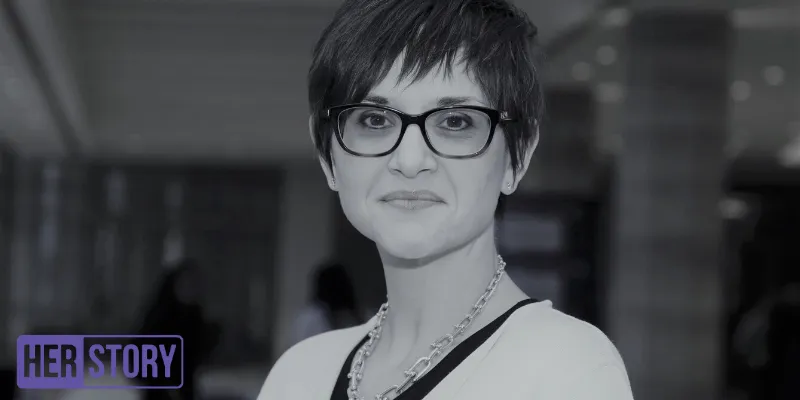We need more role models to encourage women in tech, says Genefa Murphy, CMO, Micro Focus
Genefa Murphy is CMO for Micro Focus, one of the world’s top 10 enterprise software companies. A passionate supporter of women – and women leaders - in tech, she strongly believes in the role model approach.
Genefa Murphy, Chief Marketing Officer for Micro Focus, has had a rich and varied career. The 36-year-old was born in the UK, and currently lives in California. She has a degree in Business IT and a PhD in New Technology Adoption. She started her career as an IT consultant with British Airways and donned various roles as a technology enthusiast, looking for new opportunities to break the mould, and push herself and her teams to the next level. She is also a passionate supporter of women in technology and advocates for them globally.
In an interview with HerStory, Genefa Murphy talks about Micro Focus’ far-reaching programmes, its work in India, and how digital transformation has helped women in technology.

HerStory: Your career has seen a varied path. Can you trace your journey?
Genefa Murphy: I started out as a consultant working onsite with customers, helping automate and transform their business processes using IT. From there I moved to various roles in product management for then Hewlett Packard; it was through that role that I developed a passion for a customer-centric approach and blending business and technology in a real and practical way. I did a brief stint with the CTO of HP, helping to work on new product innovations in the cloud and mobility space. From there, I went back to product management and eventually into marketing.
Leading marketing provides an opportunity to address all aspects of the business and technology domain, and as a CMO, no two days are the same. One day I can be sitting in our Silicon Valley Headquarters working on our internal digital transformation, helping to make technology selections for our team; the next, I can be presenting the Micro Focus point of view to customers and partners in India; or partnering with my peers to build out a strategy to succeed in the marketplace and deliver for our customers, employees, and shareholders.
HS: As CMO for Micro Focus, what is it that you do?
GM: As the CMO for Micro Focus, one of the world’s top 10 enterprise software companies, my team and I work across our 40,000 global customers and partners across industries to define the narrative for Micro Focus in the market and represent the voice of the customer back into the organisation; influencing product direction, Go-To-Market (GTM) models, and ensuring Micro Focus provides its customers with a unique and prescriptive point of view on how to address the challenges of today’s hyper-competitive market.
The Micro Focus marketing organisation drives global and regional programmes across all five Micro Focus product groups, support, and services, and owns the Micro Focus digital presence, including customer communities and the Micro Focus brand. My team also supports internal communications for the company, and I am the executive sponsor for our Corporate Social Responsibility programme called Micro Focus INSPIRE.
HS: What are your plans for India? And how do you hope to achieve them?
GM: India is a key hub for Micro Focus. We have significant product development work being done in India, particularly in the following product groups: security (identity access, SIEM, and unified endpoint management), information management & governance, and IT operations management (operations bridge, hybrid cloud management, data centre management, network operations management, data protector). Some of the specific centres of excellence we have include containerised micro services, analytics, UX/UI, application and infrastructure performance management, multi-cloud management, and network virtualisation. We also have a large professional services team here delivering on a global scale.
The talent available in India – particularly in R&D – is some of the best in the world.
I hosted our first Women in Technology roundtables in Bengaluru and Mumbai, where we brought together women in various roles in the technology space, leaders and non-leaders, to share their thoughts, opinions and challenges, and celebrate their wins.
HS: Can you tell us more about your global and regional programmes?
GM: Micro Focus recently internally launched the INSPIRE programme to help amplify and align both current and future efforts. This framework ensures there is a continuing commitment to behaving responsibly and contributing to economic development, while improving the quality of life of our workforce and their families, as well as those of our local communities and society.
Inclusion and diversity - in particular women in the workforce and as part of leadership - are key initiatives under this programme.
Similarly, several years ago Micro Focus launched SHINE, a network to unite, inspire, and empower women across Micro Focus and help them reach their full potential. Over the past year, in my role in marketing, my team and I have ensured that Micro Focus SHINE is represented at all major internal and customer-facing events, helping to create greater awareness and support for the topic in the community as a whole.
We also have our Data Gals team, which is dedicated to supporting women in tech in the area of big data and analytics.
Micro Focus also actively partners with third parties to further the women in tech agenda.
HS: What are the current challenges women in IT face today?
GM: There are a number of challenges but two stand out:
- In the technology world, a lot of people look to tech startups and giants as role models for how they should behave and perform, but there are not enough female leaders who can act as role models. This sets the wrong image for what it takes to be a success in the world of innovation and tech.
- The other issue is cultural and involves the demographics of the workforce. A lot of senior positions are held by those in a different demographic, who are potentially less conscious of the bias that exists in the workplace. This is not through fault, but simply a different demographic culture and mindset that has not necessarily “grown up” appreciating that diversity bias exists and therefore needs to be addressed head-on.
HS: How will digital transformation help in the current scenario?
GM: Digital transformation is a great enabler for women in technology as it opens up new avenues and ways of working – though the same applies to males as well. In many cases, cultural and societal norms often mean that women do not pursue a career, particularly one in tech because they have to dedicate their time to being at home. Digital transformation brings new levels of flexibility to women who find themselves in those situations because essentially, they can work from anywhere and can have the flexibility needed to manage both, their careers, and their home life.
As a woman in tech and a working mother, digital transformation means that I can be with my children when I need to be, but still be connected and participate in a team call happening across the world - in India for example, thanks to multi-device systems access or because my team and I can leverage digital transformation to automate business processes. I have more time to dedicate to both, my team and my family.
HS: What more can be done to encourage women to STEM and retain them in the workforce?
GM: I am a big believer in the role model approach. The more we highlight the contribution of women in the areas of STEM, younger women and students will see this as the norm and a path that can lead to success.
In terms of workforce retention, this is the same with any workforce retention programme: we have to focus on the individual and create an environment where contribution, effort, and talent are recognised and rewarded as a normal part of business.
HS: How can the talent requirement in the industry be bridged through inclusive work environment?
GM: An inclusive work environment will provide the platform to nurture and encourage women in tech. The more inclusive an environment, the more likely it is that women will be recognised and rewarded for their contributions. It’s also more likely women will feel comfortable to stand up and be heard without fear of retribution or being classified as overly aggressive.
It is also equally important that as an individual, you learn to control your own narrative and have the will and passion to drive that forward despite obstacles such as conscious or unconscious bias.
HS: Do you also mentor women?
GM: I work with women and men to mentor them. I meet them regularly to provide career advice and help them navigate everyday situations in the workplace and define their career path. As a mentor and leader, it is my responsibility to challenge thinking and offer a different perspective on a topic or situation to help the individual(s) get to the optimal outcome.
HS: What are your future plans?
GM: We plan to continue to build momentum within India on the initiatives that are currently in place, and to ensure that Women in Tech, for customers and partners we work with, have a voice. India has a large pool of talent and R&D in science and technology is at the core of economic growth. Therefore, it represents an ideal place where we can help to progress the awareness and celebration on Women in Tech and in particular Women Leaders in Tech.
(Edited by Teja Lele Desai)









